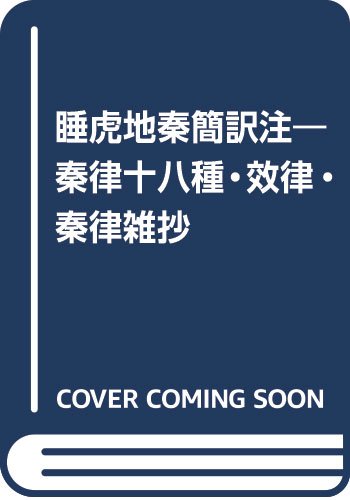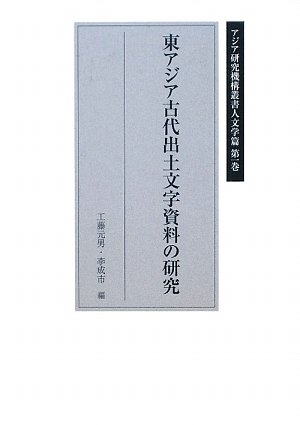3 0 0 0 OA 包山楚簡「卜筮祭禱簡」の構造とシステム
- 著者
- 工藤 元男
- 出版者
- 東洋史研究會
- 雑誌
- 東洋史研究 (ISSN:03869059)
- 巻号頁・発行日
- vol.59, no.4, pp.645-674, 2001-03-31
- 被引用文献数
- 1
2 0 0 0 OA (書評)池田雄一著「「李〓の法経について」(中央大学文学部紀要(史学科)第二九号)」
- 著者
- 工藤 元男
- 出版者
- 法制史学会
- 雑誌
- 法制史研究 (ISSN:04412508)
- 巻号頁・発行日
- vol.1985, no.35, pp.321-323, 1986-03-30 (Released:2009-11-16)
- 著者
- 工藤 元男
- 出版者
- メトロポリタン史学会
- 雑誌
- メトロポリタン史学 (ISSN:18807542)
- 巻号頁・発行日
- vol.5, pp.3-23, 2009-12
- 被引用文献数
- 1
1 0 0 0 睡虎地秦簡訳注 : 秦律十八種・效律・秦律雑抄
1 0 0 0 四川・雲南・チベット
1 0 0 0 中国古代文明の形成と展開
- 著者
- 工藤元男著
- 出版者
- トランスアート (発売)
- 巻号頁・発行日
- 2003
1 0 0 0 IR 睡虎地秦簡よりみた秦代の国家と社会
1 0 0 0 二年律令與奏讞書 : 張家山二四七號漢墓出土法律文獻釋讀
- 著者
- 彭浩 陳偉 工藤元男編
- 出版者
- 上海古籍出版社
- 巻号頁・発行日
- 2007
1 0 0 0 四川岷江上游历史文化研究
- 著者
- 冉光荣 工藤元男主编
- 出版者
- 四川大学出版社
- 巻号頁・発行日
- 1996
1 0 0 0 OA 睡虎地秦簡よりみた秦代の国家と社会
1 0 0 0 戦国縦横家書 : 馬王堆帛書
- 著者
- 工藤元男 早苗良雄 藤田勝久訳注
- 出版者
- 朋友書店
- 巻号頁・発行日
- 1993
1 0 0 0 占いと中国古代の社会 : 発掘された古文献が語る
1 0 0 0 睡虎地秦簡よりみた秦代の國家と社會
1 0 0 0 東アジア古代出土文字資料の研究
1 0 0 0 中国四川西部人文历史文化综合研究
- 著者
- 卢丁 (日)工藤元男主编
- 出版者
- 四川大学出版社
- 巻号頁・発行日
- 2003
1 0 0 0 IR 具注曆の淵源 : 「日書」・「視日」・「質日」の閒
- 著者
- 工藤 元男
- 出版者
- 東洋史研究会
- 雑誌
- 東洋史研究 (ISSN:03869059)
- 巻号頁・発行日
- vol.72, no.2, pp.222-254, 2013-09
In this paper, the author analyzes the relation among the rishu 日書, shiri 視日, and zhiri 質日 on the basis of excavated written materials that have attracted attention in recent years and considers the background of the formation of the juzhuli 具注暦, an annotated calendar. The calendar, called the lipu 暦譜, was produced by the central government every year, and edited into several versions in the process of its dissemination to local areas from the center, and these calendars were used for various purposes. The shiri and zhiri may have been made at the most local levels of the government administration for a variety of functions. Calling the shiri (reading-the-day calendar) which contained solar terms, festivals, and annotations might be derived from the idea of a calendar being for "reading" (shi 視) the good and/or bad omens of a day. A precursor of the shiri was an official post of the same name seen in Chu bamboo strips. It is thought that the shiri that appears in the Chu strips was an official who "read" good or bad omens for the day when a legal appeal was received. The duties of the shiri were carried on in later generations by Zhou Wen of the late Qin era, as well is the gongche that appear in the practices of the reign of Emperor Ming of the Later Han dynasty ; and in connection with this, one of the calendars made especially for reading good or bad omens for certain days was the qinian shiri 七年視日 (Yuanguang yuannian lipu 元光元年暦譜). The juzhuli may have be born out of such trends. In contrast, the zhiri was a calendar used exclusively as an official note for officials to record public activities. At first glance, the zhiri closely resembles the shiri, but the zhiri has no calendrical annotations ; and therein we can distinctly see the differing functions of the two. As far as can be gleaned from the circumstances of their excavation, the rishu emerged, by way of contrast, in the Chu state during the late Warring States period, passed through the periods of the Qin state and the Qin empire, and were concentrated in reigns of Emperor Wen and Emperor Jing in the Former Han. They existed as late as the end of the Former Han and into the early Later Han. Most of the owners of tombs who buried rishu belonged to the lower official class in the commanderies and counties. It can be surmised that the bureaucracy and the commandery-and-county system developed at this time as the background to such a situation. For the local official class who frequently made official trips as a result of this reorganization of the government system, the rishu was an indispensable tool for divining the future. In other words, the development of the bureaucracy and commandery-county system increased occasions for official trips, and the rishu and shiri, as well as the zhiri, as a note of official trips, emerged at the time as reflections of such circumstances.
1 0 0 0 IR 具注曆の淵源 : 「日書」・「視日」・「質日」の閒
- 著者
- 工藤 元男
- 出版者
- 東洋史研究会
- 雑誌
- 東洋史研究 (ISSN:03869059)
- 巻号頁・発行日
- vol.72, no.2, pp.222-254, 2013-09











